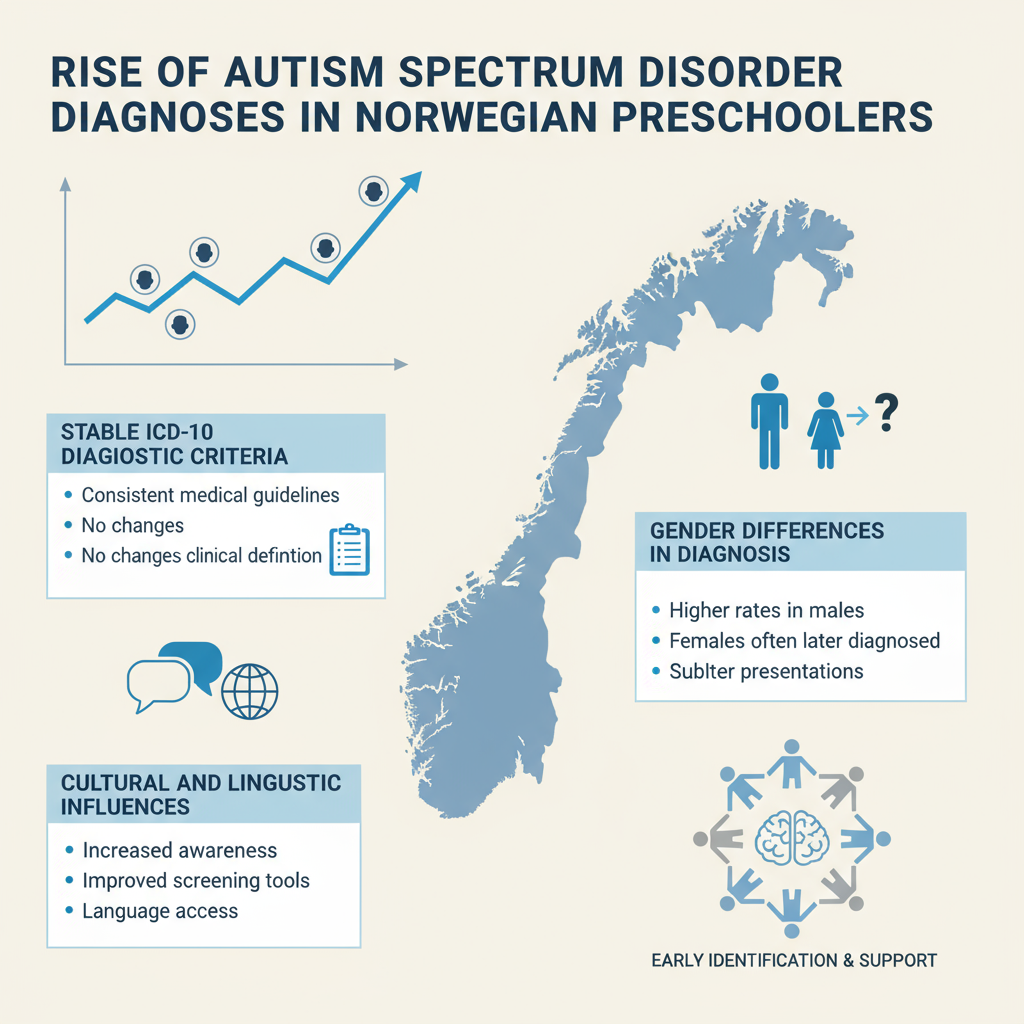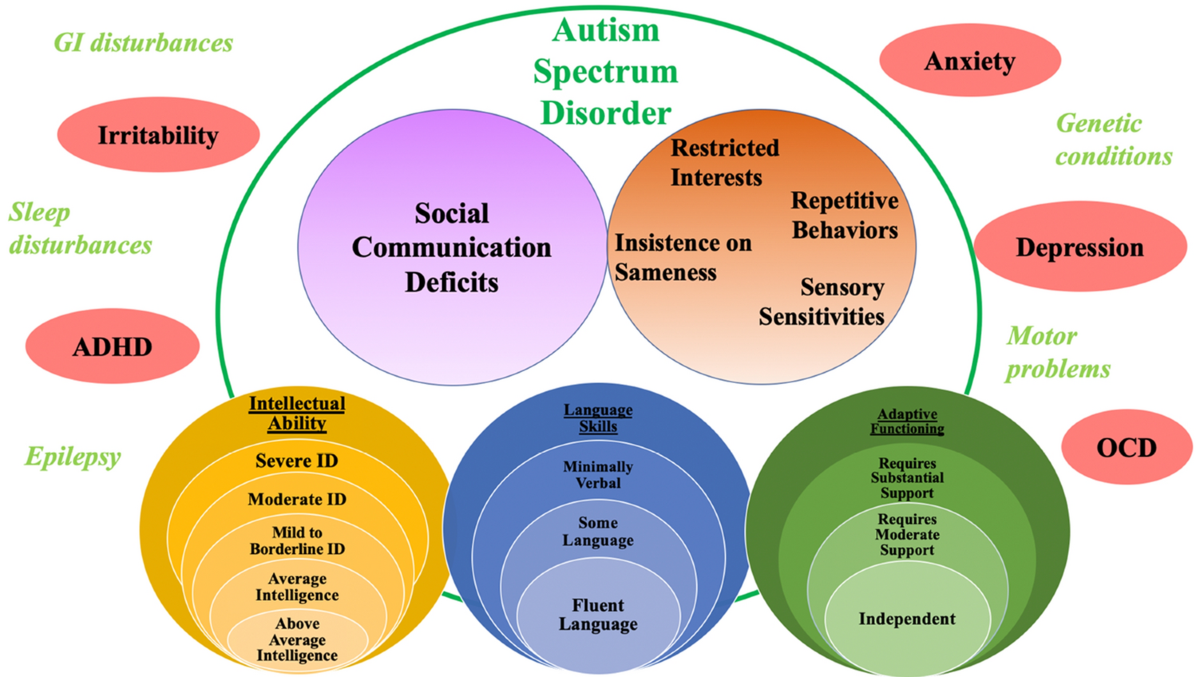
Rise of ASD Diagnoses in Norwegian Preschoolers: Stable Criteria and Influencing Factors
Recent years have seen a notable rise in autism spectrum disorder (ASD) diagnoses among Norwegian preschoolers, likely reflecting a genuine increase in children exhibiting behaviors that meet stable ICD-10 diagnostic criteria rather than changes in those criteria. Norway has maintained consistent, narrowly defined diagnostic standards since the late 1990s, with population studies estimating an ASD prevalence of around 0.9% by age 12. Differences in diagnostic systems, such as ICD-10 used in Norway versus DSM-5 or ICD-11 elsewhere, complicate international comparisons. Additionally, cultural and linguistic factors, including bilingualism and immigrant backgrounds, influence assessment outcomes and diagnostic timing. Gender disparities also exist, with boys more often and earlier diagnosed than girls, who may display subtler symptoms leading to later identification. Understanding these diagnostic trends requires considering stable criteria alongside cultural, linguistic, and gender-related influences to improve accuracy and support for all children with ASD.
Summary
Understanding the Rise of Autism Spectrum Disorder Diagnoses in Norwegian Preschoolers
Recent years have seen a notable increase in autism spectrum disorder (ASD) diagnoses among preschool-aged children in Norway. This trend prompts important questions about the reasons behind the rise and the factors influencing diagnostic practices. An in-depth examination reveals that this increase is likely a reflection of a genuine rise in children exhibiting behaviors that meet stable diagnostic criteria rather than shifts in those criteria themselves.
Stable Diagnostic Criteria and Rising ASD Prevalence
Norway has consistently applied the International Classification of Diseases, Tenth Revision (ICD-10) criteria for ASD diagnosis since the late 1990s. These diagnostic standards have remained stable and narrowly defined during this period, supporting the conclusion that the increased number of diagnoses corresponds to a real increase in the prevalence of behavioral traits meeting the clinical threshold for ASD. Population studies in Norway estimate an ASD prevalence around 0.9% by age 12, indicating a significant presence of diagnosed cases within the child population.
Impact of Diagnostic Systems on Prevalence Data
Norway's reliance on ICD-10 contrasts with other countries that utilize diagnostic frameworks such as the Diagnostic and Statistical Manual of Mental Disorders, Fifth Edition (DSM-5), or the more recent ICD-11. The DSM-5 encompasses a broader range of autism spectrum conditions, potentially resulting in higher reported prevalence rates, while ICD-11 introduces updated terminology and diagnostic criteria. These variations contribute to challenges in making direct cross-national comparisons of ASD prevalence and underscore the necessity of contextualizing data within the specific diagnostic system used.
Cultural and Linguistic Influences on ASD Diagnosis
The diagnostic process is further complicated by cultural and linguistic factors. Bilingualism and immigrant backgrounds among children have been shown to influence performance on psychological assessments used in diagnosing ASD. Differences in language proficiency, cultural norms, and developmental trajectories can affect test outcomes, potentially leading to delayed identification or misdiagnosis. These challenges highlight the importance of culturally informed diagnostic practices that account for diverse backgrounds to ensure accuracy and timely detection.
Gender Differences in ASD Diagnosis
Gender disparities also play a significant role in ASD diagnosis in Norway. Boys are more frequently and earlier diagnosed compared to girls. Girls often exhibit subtler symptom presentations and social behaviors that can mask autistic traits, resulting in later or missed diagnoses, sometimes extending into adolescence. Recognition of these gender differences is critical for refining diagnostic approaches and providing appropriate support for all affected children.
Conclusion
The observed increase in ASD diagnoses among Norwegian preschoolers reflects a true rise in behavioral markers that meet established ICD-10 criteria rather than a broadening or alteration of diagnostic standards. However, this trend must be understood within the context of cultural considerations, bilingualism, and gender-specific diagnostic challenges, all of which influence behavioral trajectories and timing of diagnosis. Additionally, variations between diagnostic systems like ICD-10, DSM-5, and ICD-11 complicate international prevalence comparisons, underscoring the need for nuanced interpretation of data. As research advances, incorporating these factors will be essential to enhance diagnostic stability and support for children with ASD across diverse populations.

Frequently Asked Questions
Q: Why is autism increasing in preschool children
A: The perceived increase in autism diagnosis in preschool children is largely due to improved awareness, better diagnostic tools, and broader diagnostic criteria rather than a definitive rise in the actual number of cases. More professionals and parents recognize and evaluate signs of autism earlier, leading to more children being identified at younger ages. Environmental factors and genetic research continue to be studied, but current evidence suggests that changes in reporting and diagnosis practices are the primary reasons for the observed increase.
Q: Impact of bilingualism on autism diagnosis
A: Bilingualism can influence the diagnosis of autism spectrum disorder (ASD) by sometimes complicating the assessment of language development and social communication skills. Children who are bilingual might show different language acquisition patterns, which can be mistaken for delays or atypical communication associated with autism. However, research indicates that bilingual exposure does not cause or worsen autism symptoms, and bilingual children with autism can benefit from communication in multiple languages. Accurate diagnosis requires careful evaluation to distinguish between language differences due to bilingualism and autism-related communication challenges.
Q: Autism diagnostic criteria in Norway
A: In Norway, autism is diagnosed based on criteria consistent with the International Classification of Diseases (ICD-10) or the newer ICD-11 guidelines used by health professionals. The assessment typically involves a multidisciplinary team evaluating social communication difficulties, restricted interests, and repetitive behaviors. Diagnosis also considers developmental history and symptom severity, following standards similar to those established by the DSM-5. Norwegian healthcare services emphasize early detection and individualized support planning following diagnosis.
Q: Differences between ICD-10 and DSM-5 in autism diagnosis
A: The ICD-10 and DSM-5 differ in their approach to autism diagnosis primarily in structure and criteria. ICD-10 categorizes autism under 'Pervasive Developmental Disorders,' listing several distinct diagnoses like Childhood Autism and Asperger's Syndrome. In contrast, DSM-5 combines these under a single diagnosis: Autism Spectrum Disorder (ASD), emphasizing a spectrum approach with varying levels of severity. DSM-5 criteria focus on persistent deficits in social communication and restricted, repetitive behaviors, while ICD-10 criteria are more categorical and less detailed. Overall, DSM-5 aims for a more unified, spectrum-based diagnosis compared to ICD-10's segmented categories.
Q: How societal factors affect ASD diagnosis
A: Societal factors such as cultural beliefs, stigma, access to healthcare, and educational resources significantly influence the diagnosis of Autism Spectrum Disorder (ASD). In communities where awareness and understanding of ASD are low, symptoms may be overlooked or misinterpreted, delaying diagnosis. Socioeconomic status also plays a role; families with limited resources may face barriers to obtaining evaluations and interventions. Additionally, cultural differences can affect how behaviors are perceived, impacting whether and when a diagnosis is pursued.
Key Entities
Mila Vulchanova: Mila Vulchanova is a linguist and expert in sign language research, contributing significant knowledge to the study of communication among deaf communities. Her work is relevant in discussions about language accessibility and healthcare communication for the deaf.
Norwegian clinicians: Norwegian clinicians are healthcare professionals providing medical care within Norway's healthcare system. They play a crucial role in implementing health policies and managing patient treatment across various medical specialties.
Norwegian healthcare: Norwegian healthcare is a publicly funded system known for its universal coverage and high-quality services. It emphasizes equitable access to medical care, including specialized treatments and preventive services.
Kamp-Becker et al.: Kamp-Becker et al. refers to a group of researchers who have published studies on healthcare or clinical topics, contributing valuable scientific insights. Their work is often cited in the context of medical research or health policy analysis.
Arendalsuka: Arendalsuka is an annual political festival in Norway that serves as a forum for public debate on social and political issues. It brings together policymakers, healthcare professionals, and the public to discuss topics including healthcare development.
External articles
- Prevalence of Autism in Scandinavian Countries (Denmark ...
- The changing faces of autism: The fluctuating international ...
- Diagnosing autism spectrum disorder among children in ...
Articles in same category
- Ticagrelor Safety and Efficacy Under Scrutiny Due to PLATO Trial Flaws
- Exploring the Link Between Viruses and Neurological Diseases: Epstein–Barr Virus and Beyond
- Modern Nutrition Insights: Fats, Supplements, and Gut Health for Optimal Performance
YouTube Video
Title: Autism diagnosis criteria: explained (DSM-5)
Channel: Yo Samdy Sam
URL: https://www.youtube.com/watch?v=1yva4RZW_s0
Published: 5 years ago
Health